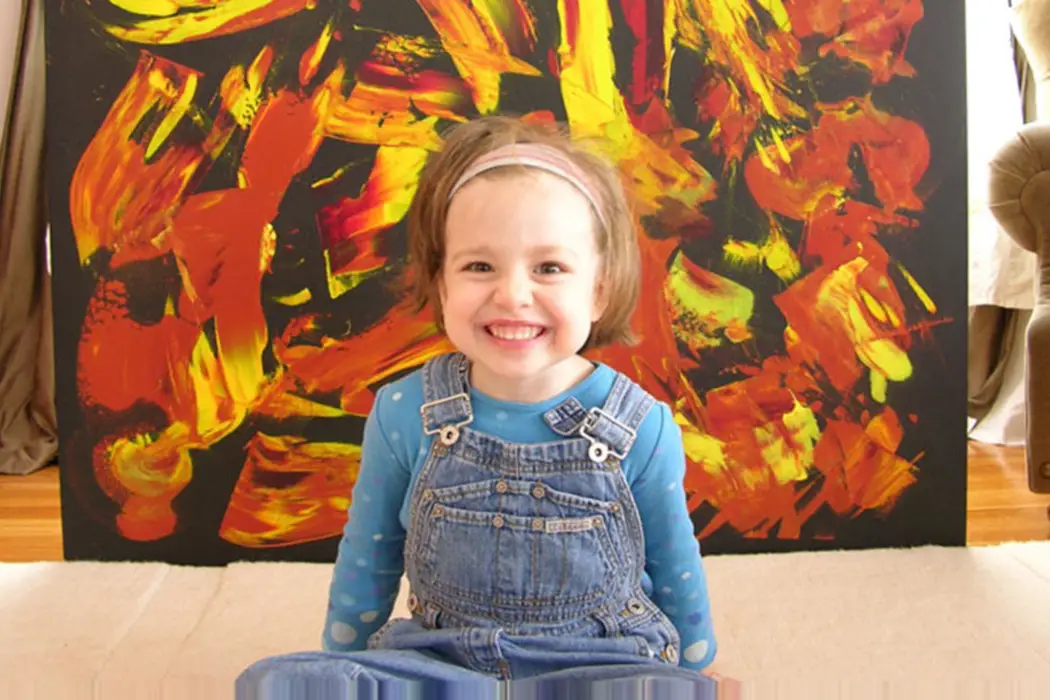10 Years Ago, MY KID COULD PAINT THAT Deconstructed The Auteur

Midwesterner, movie lover, cinnamon enthusiast.
In 2004, a four-year-old girl named Marla Olmstead started to gain critical acclaim in New York’s art scene. Not long after becoming a national headline as a childhood prodigy did controversy start to bubble up around the validity of Marla’s work. Is it possible that a child could have produced this work, or is she just a pawn under her parent’s direction?
Ten years ago, filmmaker Amir Bar-Lev made My Kid Could Paint That, a documentary that extrapolates on the controversy behind Marla’s artwork. For a documentary, the film was fairly successful, presumably because of the uniqueness of its central mystery, but My Kid Could Paint That is about much more than its synopsis could capture. The film isn’t about whether or not Marla is a prodigy painter. Instead, it wallows in this ambiguity, attempting to showcase the irrelevancy of the author.
Child Prodigy or Child Exploitation?
There are two facts that make this story so interesting: 1) the child’s father is a painter, and 2) many people consider abstract art to be a series of random choices thrown together. So, unlike a representational piece of art, like, say the Mona Lisa, which is very obviously an intentionally composed rendering, the intention of abstract art is not so obvious. Thus, My Kid Could Paint That, hence the title’s play on a classic idiom, preys on this question: Is this really a child prodigy, or is it a good painter who is exploiting his child and the public’s idea of the seemingly accidental nature of abstract art for big bucks?
Marla is elusive. Nobody can seem to catch her painting on camera. Or, when she does use paint on camera, she just puts paint blobs on top of one another, like many four-year-olds would do. She also refuses to talk about the art or her process. Her father tells Bar-Lev that he’s frustrated by her camera-shyness. We can never know whether he’s telling the truth or whether he’s covering up the fact that he’s actually the artist.

Early on, a gallery owner talks about the perfect image of the family. They’re adorable. In other words, they’re perfectly marketable. It’s quite obvious that the gallery owner could care less about whether she is actually painting it or not. He’s selling out of Marla’s work. Truth or not, it’s good marketing. Likewise, throughout the film, the father seems entranced by the prospect of Marla’s success. Highlighting these points of view is important, so the film can show us the monetary and social incentives of faking Marla’s work, and thereby adding to the ambiguity of whether she is the actual artist of these paintings.
While the film is subtly indicting the art world for this marketability — this film is very much aware of how the inherent purity of art is perverted by the infrastructure of the art world, or the commodification of art — it’s more interested in the basic fact that the audience is captivated by the story behind Marla’s work. The film also talks about the news cycle when Marla’s work became a headline. The media metabolized this ambiguity, and begged whether there is a controversy here, that perhaps it was too good to be Marla’s work.
Authorial Ambiguity
Whenever I think about authorial intention or any instance of an authorial ambiguity, I think about James Frey and his faux-memoir A Million Little Pieces. The book, marketed as his personal history with alcohol and drug abuse, was mercurial, topping the New York Times Best Seller list for more than a dozen straight weeks before being outed as fictional.
Sure, lying to the public was kind of a scummy thing to do (although I’ve always been tempted to argue that this was just good marketing). At the same time, that doesn’t have to weaken the fact that people responded emotionally to his work. Why do we need a real life or true story context and application for art in order for it to mean something? Why is my mom more interested in seeing film’s that are preceded by the text “Based On A True Story”? These questions are at the core of My Kid Could Paint That. I don’t know the answer to these questions — I think it has something to do with our need to weave narratives and construct canons of good and bad in order to make sense of the world around us (“We tell ourselves stories in order to live,” Joan Didion is famous for saying) — but I know that art has more to offer us than what the artist intended.
The Death of the Author
In 1967, the French post-structuralist Roland Barthes wrote an essay called “The Death of the Author,” which provides the seminal text of arguing for the irrelevancy of the author. “A text’s unity lies not in its origin but in its destination,” he wrote. “Critical criticism has never paid attention to the reader.”
The essay goes on to argue that the importance of the author (or the “individual”) is something that has been deeply embedded in society for ages, and is now the “epitome and culmination of capitalist ideology, which has attached the greatest importance to ‘the person’ of the author.” He ends the piece by saying this is a myth that we must dispose of: “The birth of the reader must be at the cost of the death of the Author.”

Barthes understood that the most interesting aspect of art is not who made it, but how we apprehend it. Art intersects with our lives and often acts as our companion, because of our own experiences.
In the film, various buyers of Marla’s art talk about their attraction to her work. One man talks about the spirituality of a blue door that he found in one of her paintings. It’s off to the side and, to him, symbolizes an entry way with two characters on each side. He’s moved by this work. If he found out today that Marla didn’t do it, should that minimize what the painting means to him? Of course not. He has brought his own history and set of beliefs to this work, separate from the intention of the artist, whoever that is.
Do you think Marla did the paintings? Do you think it matters whether she did or not? Share in the comments.
Does content like this matter to you?
Become a Member and support film journalism. Unlock access to all of Film Inquiry`s great articles. Join a community of like-minded readers who are passionate about cinema - get access to our private members Network, give back to independent filmmakers, and more.












